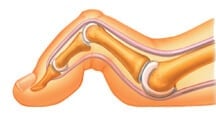Crooked Toes and Hammertoes

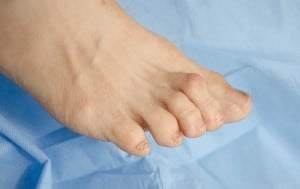
HAMMERTOES
A hammertoe is a foot problem that is usually caused by genetics but irritated by wearing high heels, and so most commonly affects women. While a healthy young person may get blisters or calluses, the diabetic patient can form an ulcer and easily get infected. Diabetic wounds often lead to amputations, so these should be addressed with your local area Pittsburgh podiatrist.
What is a Hammertoe?
A hammertoe is popularly considered a bent stiff deformed toe that rubs in shoes. This buckling or contraction of the toe is often found in diabetics who have weakened muscles, then the hamertoe rubs in shoes, poor circulation in diabetic patients doesn’t allow the area to heal leading to worse problems and often infected wounds.
What Causes Hammertoes?
Hammertoes are usually caused by ill-fitting footwear, such as high heels, that eventually can cause a toe to stiffen into a claw-like position. Eventually, a hammertoe can cause your whole foot to suffer, including the ball of the foot. You can also develop corns, blisters, calluses and ulcerations. Although hammertoes usually affect women, men can develop them too.
Sometimes, patients who have diabetes may have nerve damage that eventually leads to hammertoes. Regularly, if your have a bunion, usually you can have signs of a hammertoe, this is cause by bunion that pushes your big toe up under the second toe which then arches.
How are Hammertoes Diagnosed?
If your toe’s range of motion becomes limited, and can’t be fixed with conventional methods, there are several surgeries that can be performed. Your podiatrist will evaluate your toes and let you know which surgical treatment is best for your situation.
How are Hammertoes Treated?
Sometimes, hammertoes can be treated using home remedies, like using corn pads or wearing wider shoes that allow your toes extra room. However, if the damage becomes severe, hammertoes can be fixed with a simple, minimally invasive, 15-minute office procedure. The toe’s contracted tendons are reduced, the toe is straightened, and an artificial joint may be used to stabilize the toe.
If you’re forming hammertoes, call Beaver Valley Foot Clinic so that you can discuss your options with Dr. Christina. This common foot problem can be fixed quickly and you’ll be walking normally within no time.
Hammertoe treatments
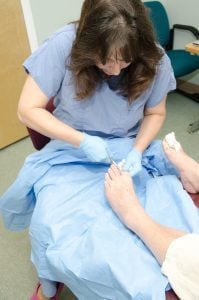
If conservative treatment is started early there’s a good chance that surgery can be avoided. The following self-care measures have proven helpful:
- Wear shoes and boots which fit properly. Depending on what your needs are these may have low heels, good arch support, or roomier toe-boxes. If you’re still having problems with commercially available brands you may want to consider custom shoes.
- Wear sandals and other open-toed footwear. These generally don’t give the best support yet by definition provide the toes with plenty of room.
- Pad your toes. Several effective products exist such as moleskin pads and toe tubes. This approach works better on toes which are still somewhat mobile.
- Wear orthotics or other inserts. The support they provide can put the foot in a more ergonomic position. In turn, this can alter the foot’s biomechanics so the toes aren’t put under abnormal stress. Again, this works better on toes which aren’t fixed and have some movement.
- Properly treat corns and calluses. This is typically done with moleskin pads or other soft, cushioning material. This can allow a patient to walk more normally and therefore reduce undue stress on the toes.
- Take non-prescription pain medication, especially Non-Steroidal Anti-Inflammatory drugs (NSAIDs). These relieve both pain and inflammation and can provide symptomatic relief. Common NSAIDS are aspirin, Aleve (Naproxen Sodium), and Motrin (ibuprofen). Although these medications are generally safe it’s still important to follow the directions on the package exactly.
The following apply to mobile, “pre” hammer toes or other deformities. It’s unlikely that these methods will work if the deformity is fixed.
- Taping the toes. Assuming that the toe deformity is on the 2nd (long) toe, begin by loosely wrapping the 1st (great) toe. Continue, going over the hammertoe and under the next toe in something of a figure 8 pattern.
- This uses the adjacent toes as splints to help to hold the affected toe straighter. This can improve symptoms immediately and begin to “train” the toe to return to a more normal position. It’s unlikely that this will permanently straighten the toe, however.
- Specialty devices which perform this same function. Various splints, slings, and toe-caps are specifically designed to hold the affected toe in a neutral positon. They’re often easier to wear and more comfortable than taping.
- Physical therapy. A physical therapist or podiatrist can recommend exercises designed to keep the toe joints mobile. They also aim to strengthen the muscles which control the toes. The following are general examples, although you should still consult with the appropriate professional.
- Using your hands, gently bend your toe joints in the direction which opposes the deformity. This is as simple as it sounds. if a joint is bending downwards then stretch it in the other direction. This should always be comfortable, never painful. Stretch several times in the morning and evening, making sure to work each joint separately.Perform “towel curls.” Place a loosely crumpled towel on the floor beneath your feet. Use your toes to grab and squeeze it. Do several repetitions in the morning upon waking and in morning and before bed.
Perform “marble pickups.” Spread several marbles on a carpeted floor. Then use your toes to grasp, lift, and release them.
Unfortunately, conservative treatments don’t work in all cases. Call your doctor after three weeks if your symptoms haven’t decreased, or if your deformity begins to worsen. If you begin to develop sores or other open lesions seek help immediately. This is especially true if you’re a diabetic.
It’s also best to seek a second opinion before following through with your procedure.
Also consider the following points before undergoing corrective surgery:
- While surgery will most likely reduce your symptoms it may not improve the appearance of your foot.
- Any surgery carries some level of risk. This type of procedure is generally considered safe, yet may result in ongoing pain, infection, or other unwanted outcomes. In some cases, a second revision surgery may be needed.
- Even if the surgery is successful there’s no guarantee that your problems won’t return. This chance is increased if common-sense lifestyle changes such as wearing well-fitting footwear aren’t adopted.
Hammertoes can be painful, don’t let that stop you from enjoying your day call now 878-313-FEET (3338)
Prevention is easier than treatment
In cases of progressive joint deformities such as hammertoe lifestyle changes can stop the problem before it starts. The easiest (and most effective) of these is wearing proper footwear. Bear the following tips in mind:
- Select shoes with a roomy toe box. Avoid shoes and boots with narrow, pointed tips.
- Avoid high heels. This can stave off toe deformities and often relieves lower back pain, knee pain, and ankle pain as well.
- Pick adjustable shoe. By their very nature shoes with laces and Velcro straps provide an adjustable fit.
Observe the following tips when purchasing shoes:
- Go shoe shopping in the evening for a better fit. Your feet will naturally swell during the day as you walk and stand.
- Periodically check your shoe size. Changes in shoe size, especially width, are a common part of the aging process. If this occurs in only one foot be sure to buy shoes which fit the largest foot. Buying two different pairs is also a highly effective (if expensive) option.
- As a last resort you can take your favorite shoes to a repair shop or leatherworker. It’s often possible to stretch out the tight spots. Note that this only works on leather shoes and boots.
Diagnosis and treatment
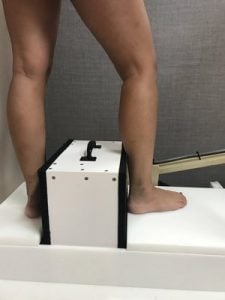
It’s highly likely that your podiatrist can arrive at a correct diagnosis by examining your feet. An X-ray study can be ordered If there’s any doubt or if joint damage is suspected. MRIs and other advanced imaging techniques are seldom needed.
A change in footwear may be all that’s required if the toe still has some degree of flexibility. Roomier, more comfortable shoes with a wide toe box are frequently recommended, Orthotic inserts are often prescribed as well. When used together this relieves pressure, reduces friction, and improves the biomechanics of the foot and ankle.
Treatments for Crooked Toes and Hammertoes in Pittsburgh
- Do your Crooked Toes rub in your shoes?
- Are there sore red spots on your toe knuckles?
- Do you suffer from corns and callouses?
There are simple office procedures that can help solve all these problems!
What Is A Hammer Toe?
Most commonly affecting the baby toe or a second toe that is a bit longer than the others, a hammer toe is a genetically inherited conditions where the toes are Crooked Toes or bent and can be very painful.
Symptoms Of Hammer Toes
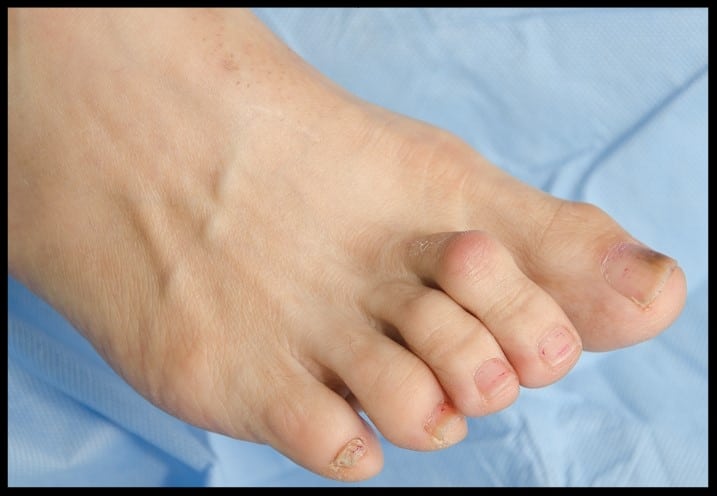
You Don’t have to live with Crooked Toes and toe pain.
For most people, unless you wear tight dress shoes, hammertoes are not a problem. But people that do dress up for work or play know what the symptoms of hammertoes are all too well! Redness at the bent knuckles, soreness where the toe rubs the shoe, and sometimes painful corns or calluses are common hammertoe symptoms. Sometimes the corns appear between the baby toe and the 4th toes and may even rub a hole in the skin, called an ulcer.
Diabetics, patients with poor circulation, and those with neuropathy are at particular risk, and may not even realize it. A small hole in the skin can lead to an infection, amputation of the toe, or even the foot.
Seek Hammer toe Treatment from a Board Certified Podiatrist
Home remedies can be dangerous; see a podiatrist if:
• Painful ball of the foot
• Unsightly appearance
• painful walking in shoes
• shoes don’t fit, or toes are cramped
• Worsening toe deformity
• Toe pain or redness on the knuckle
How Long Does It Take To Heal From Hammer Toe Surgery?
The recovery time after a hammer toes surgery depends on variety of factors, these can include severity of the condition, type of surgery used, and your overall health. But generally, it goes like this:
1. Initial Recovery: (First two weeks):
• After the surgery is finished you will need to wear special surgical shoe or boot to protect the foot and allow it heal.
• Swelling, bruising, and discomfort will be at their peak and are common in this stage but can be easily managed with pain medications and elevating the foot.
• Doctor will recommend you to not put any weight and pressure on the foot as well, for at least 2 weeks.
2. Follow-up Care (3-6 weeks):
• In this period you are allowed to put weight on your foot and doctor will be monitoring your progress.
• Doctor will also recommend physical therapy and exercises to restore flexibility and strength in the foot.
• Lastly, stitches can also be removed after 10-14 days, if non-dissolvable sutures weren’t used. 3. Full Recovery (2-6 Months):
• At this point your healing should be complete, especially if the surgery involved bone realignment or fusion, it can take anywhere from 2-6 months
• However, make sure you need to wait at least 6 months before you can completely resume activities like running or high-impact sports!
Is It Possible To Reverse Crooked Toes or Hammer Toes Without Any Surgery?
Yes, fortunately you can manage crooked toes and hammer toes without any surgery, especially if they are in their early stages. There are some non-invasive treatments that will help you prevent further progression, alleviate pain and improve foot function, here are some effective options:
• Wearing footwear that fits your feet well and provide good arch support
• Stretching exercises
• Padding and orthotics
• Pain management treatments like OTC pain relievers and anti-infla
mmatory creams
Non-surgical Treatments for Hammer Toes
As soon as you realize you have a problem with your toes, call a podiatrist. She can help you find non-operative treatments for hammer toes, or claw toes, and are geared toward decreasing spain (and/or calluses) andkeeping you from developing a much worse problem.
Simple home treatments you can do immediately are:
• Wear a wide comfortable , more squared toe box
• Use an arch support or wear supportive shoes
• cut back on activities that cause pain
• offload callused areas
• apply exfoliative callus cream daily, available through your podiatrist( over the counter ones can be dangerous
• Periodic care from your podiatrist
DO NOT use medicated callus pads with out first checking with your podiatrist
Non surgical care of hammertoes at a Drs office:
• Injections
• Toe Splints or Pads
• Custom Foot Orthotics
• Anti-inflammatory Medicines
• Physical Therapy
Hammer Toe Surgery
Straightening and/ or shortening of a painful hammertoe can be done in a single simple 15 minute office procedure. Walking is resumed immediately in a special shoe. Those with sitting jobs can office return to work aftera hammertoe surgery after as little as a long weekend. Call for details today!
Call us today 878-313-3338to schedule at any of our four Podiatry Clinics in Beaver, Butler, or Allegheny County locations, including Podiatry offices Moon Township, Ambridge, Cranberry Township’s full service Podiatric office and our newest Foot Clinic, Beaver, PA
Are there specific exercises to help with hammer toes?
Yes, there are exercises that can help alleviate the symptoms of hammer toes and improve flexibility and strength in the toes and foot muscles. Here are a few exercises that may be beneficial:
1. Toe Stretching: Sit or stand comfortably. Use your fingers to gently stretch your toes apart. Hold the stretch for 10-15 seconds, then release. Repeat several times.
2. Toe Tapping: Sit with your feet flat on the floor. Lift your toes while keeping your heels on the ground, then lower them back down. Repeat this motion for several sets.
3. Marble Pickup: Place marbles or small objects on the floor. Use your toes to pick up the marbles and place them in a container. This exercise helps improve toe dexterity.
4. Towel Stretch: Place a towel on the floor and use your toes to scrunch it up toward you. This exercise helps strengthen the muscles in the feet.
5. Resistance Band Exercise: Sit with your legs stretched out in front of you. Loop a resistance band around your toes and gently flex and point your toes against the resistance. This exercise strengthens the toe muscles.
Can hammer toes cause complications if left untreated?
Yes, if left untreated, hammer toes can lead to several complications and negatively impact your foot health and overall quality of life. Some potential complications of untreated hammer toes include:
1. Pain and Discomfort: Hammer toes can cause persistent pain, especially when wearing shoes or walking. The affected toes may rub against the inside of shoes, causing corns, calluses, and blisters.
2. Corns and Calluses: Due to the friction between the bent toes and footwear, corns and calluses can form on the tops, sides, or tips of the toes, causing additional discomfort.
3. Limited Mobility: As the condition progresses, the toes can become rigid and difficult to move. This limited mobility can affect your balance and ability to walk pr
operly.

